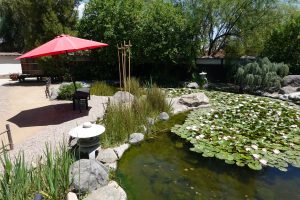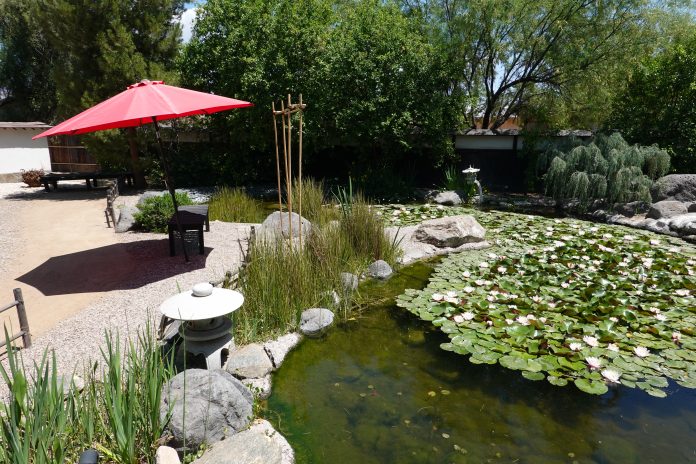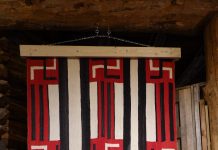When I met Patricia Deridder, Executive Director of Yume Gardens, she was ‘working’ on ikebana. I put that in quotes as ikebana is actually an art form – the Japanese art of flower arrangement. “Studying ikebana gave me a feeling of what Japanese gardens are,” she explained. “They represent nature as such. They bring in nature in a human form: not copy it, but take the essence of it.”
Yume means dream in Japanese, an appropriate name as finding a Japanese garden just off a busy street in Tucson is a dream come true. It is quite literally an oasis of calm and repose, and is meant to emulate the private gardens that once used to be a feature of many homes in Japan. Even in Kyoto, the former capital city, the number of such gardens is dwindling.
There are probably more than 200 Japanese gardens in the United States, but this one is unique in that it does not try to recreate the grounds of imperial residences or large temples in Japan. “Being a secular, private gardens makes us different.” Another distinguishing feature is the lack of pretension. You won’t find a touristy pagoda here, or flower beds bursting with colour. Yume is based on “average people aesthetics. We don’t pretend. That makes us different from other Japanese gardens.”
Sit beside the pond filled with Koi fish and the only splash of obvious colour you will see is the red umbrella over a meditation seat. But look more closely and you will see a different aspect of colour in the contrast between the green leaves and the texture of the trees, which at Yume have mostly been pruned to human size so one can relate to them. “We provide a therapeutic program that offers to contemplate life in a more positive way . It is based on several medical studies that prove the special quieting effect that Japanese gardens have. That program is also offered successfully in other Japanese gardens in the USA.”
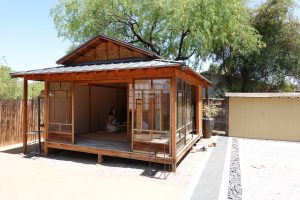 Pictured here is a replica of a traditional Japanese cottage, which includes a small alcove (tokonoma) which people used to display an artistic artifact such a hanging scroll or flower arrangement. The cottage, which some might mistake for a tea room, was built using materials from a 150-year-old farm house near Kyoto. Beside the cottage is a traditional meditation garden of raked gravel. Another gravel garden nearby features large boulders from the Santa Catalina mountains. While they are dramatically positioned, the boulders are actually best appreciated by glimpsing them through a circular opening in the wall of a courtyard garden which has at its centre a water basin whose carved characters read “enjoy the present time.” The stones around the basin, which look exactly like those used in gardens in Japan, were imported from Mexico.
Pictured here is a replica of a traditional Japanese cottage, which includes a small alcove (tokonoma) which people used to display an artistic artifact such a hanging scroll or flower arrangement. The cottage, which some might mistake for a tea room, was built using materials from a 150-year-old farm house near Kyoto. Beside the cottage is a traditional meditation garden of raked gravel. Another gravel garden nearby features large boulders from the Santa Catalina mountains. While they are dramatically positioned, the boulders are actually best appreciated by glimpsing them through a circular opening in the wall of a courtyard garden which has at its centre a water basin whose carved characters read “enjoy the present time.” The stones around the basin, which look exactly like those used in gardens in Japan, were imported from Mexico.
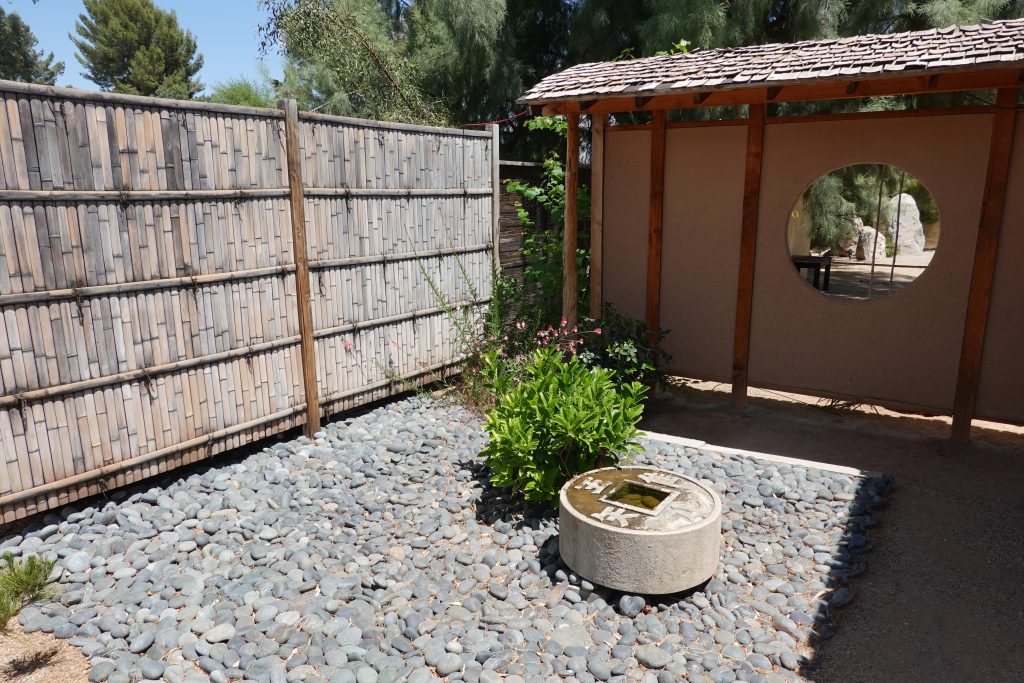
Even in this tranquil surrounding time does not stand still, as evidenced by the rich cultural activities that take place at Yume. This includes small weddings with a limit of 40 guests, and some are even now done on Zoom. A recent wedding here was broadcast so that family members in Japan and India, who could not travel due to the pandemic, were able to participate. An especially popular event here are Butoh dance performances. There are two schools of Butoh, one based on love and one on pain. Yume only offers the love option: “I don’t want any pain here!” laughed Deridder.
“Butoh is a very slow dance that brings you into a zone you don’t usually have the opportunity to go to. The dancer stands perfectly still for perhaps a few minutes. You wait for movement, and it makes you go inside. When they start moving you are already calm: you can’t appreciate that stillness without that calm,” explained Deridder, who studied in Japan for 15 years before founding Yume gardens in 2013.
Before its summer closure, there are two final events at the gardens:
Children’s Day Festival: The event will feature Taiko Drum performance by Ken Koshio (Taiko drumming, Folk music artist), kamishibai storytelling, origami, and fan (uchiwa)/lantern painting. This event will be scheduled in increments of 2 hour per time slot (10:00am-12:00pm OR 12:00pm-2:00pm). Date: May 2, 2021
Evenings at Yume: Paul Amiel of Tucson’s Empty Bamboo Shakuhachi Circle will perform evocative music on the harp and on the shakuhachi (Japanese bamboo flute) for an evening to remember. The participation in this event will be scheduled in two 1-hour time slots (6:30pm-7:30pm OR 7:30pm-8:30pm). Dates: May 7 and 8, 2021
Currently there is an art exhibit of all 53 “stations of Takaido”. The originals were created by Hiroshige between 1833 and 1834. They depict with vibrant realism the stopping points on the 300-mile trek between Tokyo and Kyoto.
Yume Gardens is at:
2130 North Alvernon Way
Tucson, Arizona 85712
Website: yumegardens.org The website is rich with information, and includes a form to fill out for those who would like to volunteer to maintain the gardens or assist with activities.
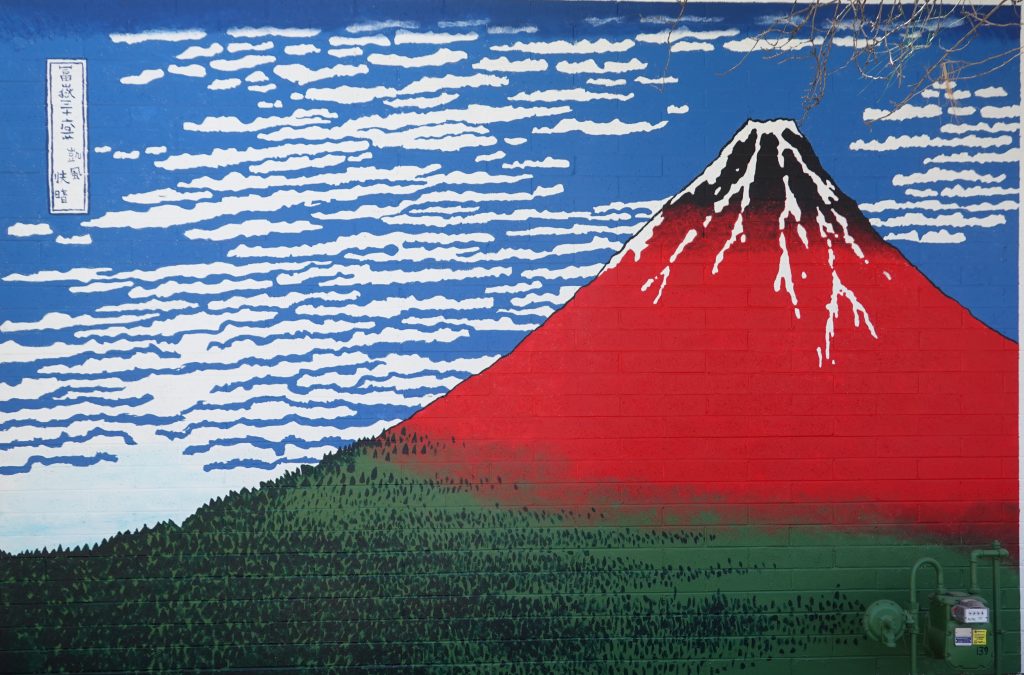
Photos by Dr C Cunningham